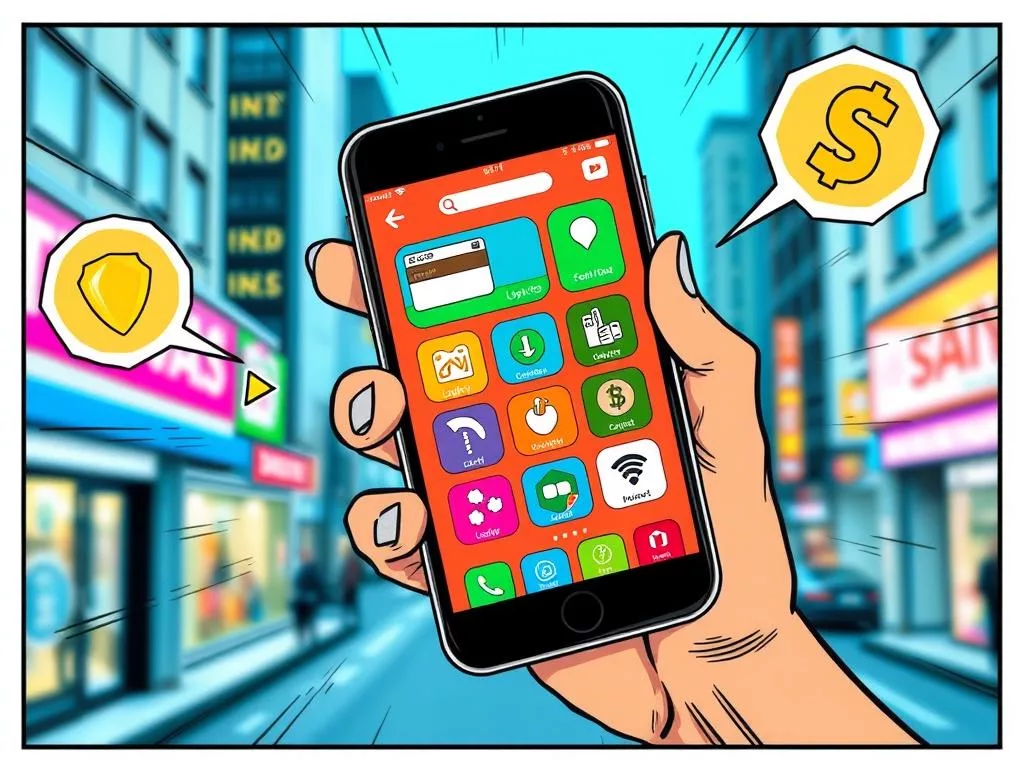Mobile wallets are changing how we handle money in the US. Options like Apple Pay, Google Pay, and Samsung Pay are popular. They make paying easy, safe, and convenient.
A study by McKinsey & Company found 89% of Americans used digital payments in 2022. Over two-thirds plan to use a digital wallet soon. This shows a move towards a cashless society.
People and businesses see the value in digital wallets. They offer better security and help those without bank access. The global market for mobile wallets is growing fast, expected to reach $7.58 trillion by 2027.
Digital wallets are changing how we pay. They store cards, passes, and more in one place. This makes managing money easier. The market is getting better with new tech like QR codes and NFC.
To learn more about mobile wallets and their impact, check out this guide. See how e-wallets are shaping the future of finance.
What is a Mobile Wallet?
A mobile wallet lets you pay with your phone, making physical wallets unnecessary. It’s a digital version of your wallet, found on smartphones. It includes Apple Wallet, Google Wallet, and Samsung Wallet. These wallets do more than just pay for things; they also store digital documents and coupons.

Mobile wallets, or e-wallets, keep your payment info safe and make transactions easy. They support many payment types, including cryptocurrencies. The apps behind these wallets ensure your payments are quick and safe, using QR codes, NFC, and Wi-Fi.
Digital wallets are key in today’s financial world. Their value is set to grow from $10 trillion to $17 trillion. The number of users is expected to jump from 4.3 billion in 2024 to 5.8 billion in 2029. They offer better security, like encryption and tokenization, making them safer than traditional payment methods.
Digital wallets come in different types, each with its own set of features:
- Closed Ecosystems: Used within a specific platform or retailer.
- Network of Affiliated Merchants: Usable across a network of allied stores.
- Full Interoperability: Offer extensive usability across multiple platforms.
- Card-based Wallets: Store and use cards digitally for transactions.
Digital wallets beat traditional payment methods in convenience, speed, and accessibility. They let you manage all your payment methods in one place. But, they’re not accepted everywhere, which can limit their use.
Mobile wallet tech makes payments faster and safer. Over 10 million stores in the U.S. accept Samsung Pay, and Apple Pay is used at millions more. Their growth shows they’re essential for the future of money transactions.
Guide to Mobile Wallet: Benefits and Drawbacks
Mobile wallets offer unmatched convenience. They let users store cards, documents, and make quick P2P transfers. Services like PayPal and Venmo have lower fees than traditional methods. NFC technology in Apple Pay and Google Pay makes payments fast and easy.

Mobile payment security is top-notch, thanks to encryption and biometric authentication. These features keep your info safe. Digital wallets use tokens for transactions, reducing the risk of card details being shared.
But, mobile wallets have their downsides. Being device-dependent can drain batteries and increase theft risks. Not all stores accept mobile payments, which limits their use. Samsung Pay, for example, has limited features in some areas.
The need for more stores to accept mobile payments is a big issue. A 2024 report by PSCU found 41% of people don’t use mobile wallets because they don’t understand them. This shows the need for better education and more store acceptance. Here’s a table comparing the pros and cons:
| Aspect | Details |
|---|---|
| Convenience | Store multiple cards and documents, quick peer-to-peer transfers, and NFC-enabled payments. |
| Security | Features like encryption, tokenization, and biometric authentication. |
| Limitations | Device dependency, battery life, risk of loss or theft, limited merchant acceptance. |
| Popular Platforms | Apple Pay, Google Pay, Samsung Pay, PayPal, Venmo, Zelle. |
Digital wallets offer many benefits and strong security. But, there are limits like merchant acceptance and device reliance. For those interested, learning about how mobile wallets change payments is key. Knowing this helps make a smart choice.
How to Use Mobile Wallets Effectively
To start using digital wallets, first set up your mobile wallet properly. Make sure your device works with the wallet app you pick. In the US, Apple Pay, Google Pay, and Samsung Pay are popular choices, supported by big banks.
Download the right app and enter your payment info. Most apps, like Apple Pay, let you add cards. Google Pay supports debit and credit cards. After adding cards, the app might ask for verification to keep your info safe.
Using mobile wallets well means knowing about their security features. They use biometric authentication, data encryption, and tokenization to protect your money. Apple Pay and Google Pay use fingerprint and facial recognition for extra security.
Mobile wallets save you from typing in card numbers for each buy. Always check if a store accepts mobile payments to avoid trouble.
Good mobile wallet use also means keeping an eye on your transactions. Many apps send updates and alerts to help you manage your money. They also have fraud detection to watch for suspicious activity.
It’s also key to watch your device’s battery to avoid transaction issues. For tips on saving on currency conversion abroad, see this guide.

